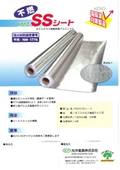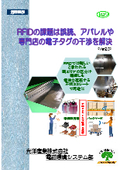Non-combustible aluminum electromagnetic wave shielding sheet (SS sheet/SS tape)
Non-combustible materials exhibit excellent strength and electromagnetic wave shielding properties, are superior in durability and workability, and facilitate easy new construction, renovation, and maintenance work.
【SS Sheet: Fireproof Material Certification Number (Non-combustible: NM-1776) F☆☆☆☆ Certification】 ● Reduction of RFID and WiFi signal interference ● Aluminum sheet reinforced with glass cloth ● Both sides are aluminum, providing unprecedented strength, making it less prone to holes or cracks from bending during installation, and excellent in workability. In case of emergencies, the joints and holes can be reinforced with conductive aluminum tape of the same material, enhancing the shielding performance. 【SS Tape】 ● Reinforcement of gaps between shielding materials, repair of holes, reinforcement of metal connections, and around openings (for shielding joints, shielding construction repairs, and joining metal to metal)
basic information
【SS Sheet】 - Even in specialized shielded room constructions (hospitals, research institutes, computer rooms, confidential leakage prevention rooms, defense-related facilities), it does not require the expertise like copper foil, and since there is no corrosion due to humidity, it excels in maintainability with no performance degradation. It can be installed with general interior work, achieving overall cost reduction. - It is also used as a non-combustible heat-insulating sheet and for preventing misreads caused by interference from electronic tags (RFID) in apparel and specialty stores (non-combustible partitions). - Used for Wi-Fi interference prevention and as a countermeasure against RFID radio wave environments. - In combination with RF absorbing IT foam, it is used as a simple shield box or AP box in the hardware and software development environment for wireless devices such as smartphones. - It is also suitable for through-wiring processing. 【SS Tape】 - By shielding the cables and connectors of electronic devices, it protects them from static electricity and electromagnetic wave interference, enabling measures against electromagnetic wave and radio wave interference, as well as static electricity removal. - When installing a freeze prevention device directly onto a resin pipe, aluminum tape treatment is necessary for the piping. (Wrap pure aluminum tape completely around the piping and ground that aluminum.)
Price information
-
Delivery Time
Applications/Examples of results
- Improvement of wireless LAN Wi-Fi radio wave environment - Interference countermeasures for electronic tags (RFID) - Shielding installation for curved surfaces - Shielding installation for EEG, EMG, and hearing test rooms - Shielded joints - For shielding construction repairs - For joining metal to metal - Shielding treatment for through-wiring
Detailed information
-

Conductive Strong Adhesive Tape (Glass Cloth Reinforced Double-Sided Aluminum Foil SS Tape) This is a tape made of the same material used to adhere non-combustible aluminum shield sheets. It is an aluminum tape reinforced with glass cloth, and the adhesive side uses a highly conductive metallic foil substrate, which provides excellent flexibility, conductivity, and thermal conductivity. It is used at joints and holes during shield installation, and the reinforcement enhances workability and improves shielding performance. Since it uses a conductive adhesive, it can achieve conductivity in the vertical (thickness) direction just by sticking it on. Being in tape form allows it to be wrapped around cables, devices, and irregular surfaces. By shielding cables and connectors of electronic devices, it protects them from static electricity and electromagnetic wave interference, enabling measures against electromagnetic wave disturbances and radio wave disturbances, as well as static electricity removal.
-

Shielding treatment for through wiring. Please also use it for fire-resistant doors.
catalog(11)
Download All Catalogs







News about this product(2)
-

Countermeasures against RFID mutual interference: The 'non-combustible (mandatory under interior restrictions) aluminum SS sheet' that shields radio waves resolves issues of radio wave interference and misreading of tags in apparel, specialty stores, and supply chains, making it possible to conduct inventory segregation in the same area, which has been considered difficult with RFID until now.
【Over 1000 successful measures】●Before the measures, the electronic tags (RFID) on the apparel store side were being read by the reader on the back-end side, causing disruptions to operations. To resolve this, we spatially separated the areas with a non-combustible SS sheet partition (constructed on the back-end wall to prevent multi-path interference, with ceiling construction depending on the environment), thereby reducing the impact of mutual interference. The non-combustible aluminum electromagnetic wave shielding sheet we used has obtained 'F☆☆☆☆ certification and fire prevention certification (non-combustible: NM-1776)'. With the reinforcement material made of sturdy glass cloth, it exhibits strength that has not been seen before, making it less prone to holes or cracks due to bending during installation, unlike conventional products. The joints and holes are reinforced with SS tape of the same material, enhancing workability and providing excellent shielding performance. It has been used after passing installation performance tests at our EMC experimental building. We receive inquiries and consultations such as "I want to use it in this kind of place?" and "I'm having trouble utilizing it effectively," and we implement and measure the improvements discussed and proposed, reflecting them in our products. 'Smiring Company,' which continuously evolves to meet the diverse needs of this era, is Koyo Sangyo Co., Ltd.
-

[Over 1000 measures implemented] A method to solve radio interference and reading errors of electronic tags (resolved through store renovations in apparel, specialty stores, supply chains, etc.) is explained with photos. The construction points of non-combustible aluminum SS sheets (essential under interior restrictions) are clearly visible at a glance.
●One day, if the electronic tag (RFID) is affected by interference, I think it would be good to use this guide to take countermeasures. ●Improvements implemented based on issues are published with photos. ●The construction procedure for the wall includes explanations with photos on the overlap of aluminum sheets, the pitch for tacker fixation, and the method of fixing with aluminum tape. ●Measures for leakage from outlets and embedded lighting fixtures that occurred during actual construction are also noted. Due to the recent pressure on radio waves leading to frequency shifts and reorganization, as well as the increase in RFID users and other wireless devices, it is not uncommon for issues such as radio wave interference to occur as a result of these influences. UHF band IC tags have a long communication distance of about 3 to 5 meters, which can lead to interference when multiple IC tag readers are installed in close proximity. In particular, in Japan, the bandwidth allocated to UHF band IC tags is narrow at 2 MHz (for high-output types, while low-output types like handheld devices have 3 MHz), making it difficult to avoid interference. Wireless sensor networks utilize the high radio reach of the 920 MHz band and, through high reliability via multi-hop communication, are accelerating wireless IoT solutions.
Recommended products
Distributors
Our mission is to add our unique ideas and know-how to the new materials that are continuously emerging, in order to meet the needs of various industries, and to propose them as new products with added functionalities. Our functional composite materials exhibit excellent and original features across various fields, including home appliances, precision equipment, medical devices, construction, and transportation, as well as in areas such as equipment parts, special rooms, and architectural panels, thereby serving everyone effectively. "Reflecting the times and exploring the next generation" is our pride in our continuous development capabilities that lead the industry. We offer a variety of electromagnetic wave countermeasure products. Furthermore, to carry out these measures effectively and efficiently, we have established a system that allows us to conduct electromagnetic wave environment measurements, field surveys, construction advice, and shielding work consistently. Technology is not born overnight. Our employees cherish a proactive attitude towards "technologies that no one is doing," "technologies that are deemed impossible," and "unique technologies." In development, not everything is successful; in fact, failures are more common. However, it is also true that the byproduct technologies born from challenges support our company today.















































